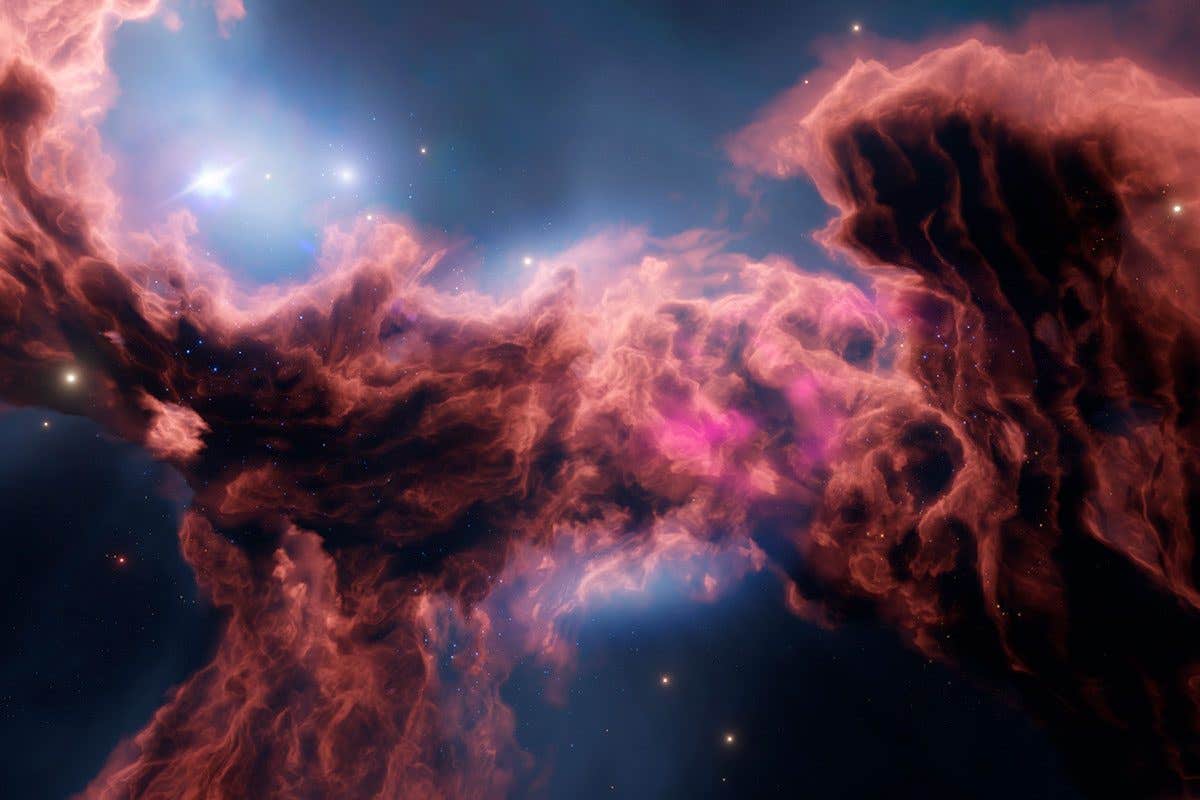Astronomers discover massive cosmic structure hiding near our solar system
A hidden gas cloud named Eos glows with ultraviolet light and reveals new insights into how stars form near our solar system.

Astronomers discover Eos, a dark molecular cloud near Earth, revealing hidden gas using ultraviolet light detection. (CREDIT: Getty Images)
A quiet, glowing gas cloud has been hiding in plain sight not far from Earth. For decades, astronomers have predicted that some of the galaxy’s molecular gas — the fuel for star birth — might be invisible using common methods. Now, that prediction has come true with the discovery of a mysterious object named Eos.
Eos isn’t just another cloud floating through space. It’s one of the largest single structures ever found near our solar system, located about 300 light-years away. That’s roughly 94 parsecs — an astronomical stone’s throw. What makes Eos so special is how it was found and what it reveals about the universe’s hidden corners.
A New Way to See What Was Hidden
Most molecular clouds — giant collections of gas and dust — are spotted using infrared or radio waves. These methods detect carbon monoxide, a gas often found with molecular hydrogen, the main component of these clouds. But not all clouds play by those rules.
Eos remained hidden because it’s “CO-dark,” meaning it barely contains carbon monoxide and doesn't emit the signals that telescopes typically look for. That’s why scientists had missed it until now. The secret to uncovering Eos came from looking at a different kind of light: far-ultraviolet.
Blakesley Burkhart, an astrophysicist from Rutgers University, led the team that discovered Eos. They used far-ultraviolet fluorescent light — a glow created when hydrogen molecules interact with high-energy ultraviolet radiation and release light. This light isn’t visible to human eyes, but it tells scientists where molecular hydrogen exists, even if carbon monoxide isn’t there.
“This is the first-ever molecular cloud discovered by looking for far ultraviolet emission of molecular hydrogen directly,” Burkhart said. “The data showed glowing hydrogen molecules detected via fluorescence in the far ultraviolet. This cloud is literally glowing in the dark.”
The light was captured by a far-ultraviolet spectrograph called FIMS-SPEAR, which flew aboard a Korean satellite named STSAT-1. When the data became publicly available in 2023, Burkhart noticed something unusual — and began digging deeper.
Related Stories
A Crescent Cloud Full of Star-Forming Fuel
Eos stretches across a sky area equal to about 40 full moons. It’s crescent-shaped and lies along the high-latitude edge of the North Polar Spur, a bright X-ray and radio feature in our galaxy. This gas cloud contains about 3,400 times the mass of the Sun, but only a tiny fraction of that shows up in carbon monoxide signals.
Using 3D dust maps, X-ray absorption data, and tracers like ionized oxygen (O VI), the scientists confirmed the cloud’s distance. It sits on the edge of the Local Bubble, a large cavity in space filled with hot gas that surrounds the solar system.
Despite its size, Eos won’t last forever. Models show that the cloud will slowly evaporate as radiation breaks it apart. In about 5.7 million years, it will likely disappear completely. That lifespan might seem long, but in cosmic terms, it’s fleeting. Still, while it lasts, Eos offers a rare chance to study how stars and planets begin to form from raw gas.
“When we look through our telescopes, we catch whole solar systems in the act of forming, but we don’t know in detail how that happens,” Burkhart explained. “Our discovery of Eos is exciting because we can now directly measure how molecular clouds are forming and dissociating, and how a galaxy begins to transform interstellar gas and dust into stars and planets.”
A Window Into the Universe’s Dark Corners
Molecular hydrogen is the most abundant molecule in the universe. It also plays a key role in the life cycle of stars, but it’s notoriously hard to observe directly. For decades, scientists believed they had to rely on carbon monoxide to trace where this gas was. Eos changes that.
“When I was in graduate school, we were told that you can’t easily directly observe molecular hydrogen,” said Thavisha Dharmawardena, a NASA Hubble Fellow and shared first author on the study. “It’s kind of wild that we can see this cloud in data that we didn’t think we would see.” The success of this approach may change how astronomers hunt for other hidden clouds in the Milky Way — and far beyond. Burkhart believes this method could even allow scientists to study molecular clouds in the early universe.
“The use of the far ultraviolet fluorescence emission technique could rewrite our understanding of the interstellar medium, uncovering hidden clouds across the galaxy and even out to the furthest detectable limits of cosmic dawn,” Dharmawardena said.
Burkhart’s team is now scanning the skies for more CO-dark clouds. They’ve even turned to the James Webb Space Telescope (JWST) to push the limits further. “Using JWST, we may have found the very furthest hydrogen molecules from the sun,” Burkhart said. “So, we have found both some of the closest and farthest using far-ultraviolet emission.”
The Long Journey of Ancient Hydrogen
The hydrogen inside Eos has had a long and epic journey. It dates all the way back to the Big Bang, over 13 billion years ago. After forming in the early universe, it traveled across space, settled in our galaxy, and finally coalesced near the Sun to become part of Eos.
“The story of the cosmos is a story of the rearrangement of atoms over billions of years,” Burkhart said. “The hydrogen that is currently in the Eos cloud existed at the time of the Big Bang and eventually fell onto our galaxy and coalesced nearby the sun. So, it’s been a long journey of 13.6 billion years for these hydrogen atoms.”
Even though Eos poses no threat to Earth, it holds tremendous value for science. It offers a close-up view of a process that usually happens far away, hidden behind dust or too faint to detect. Now that scientists know how to look for this kind of cloud, many more may soon be found.
Eos also shares its name with a proposed NASA mission aimed at finding and studying molecular hydrogen across the galaxy. This mission, still in planning stages, hopes to use similar ultraviolet techniques to understand how stars are born from dark clouds like Eos. Eos, named after the goddess of dawn, may indeed be just the beginning of a new way to see the cosmos.
Research findings are available online in the journal Nature Astronomy.
Note: The article above provided above by The Brighter Side of News.
Like these kind of feel good stories? Get The Brighter Side of News' newsletter.



